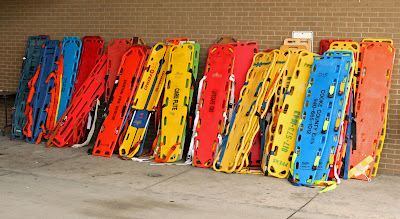
–
Continuing from Part I of an episode of the First Few Moments podcast where Kyle David Bates, Steve Murphy, Patrick Lickiss, and I discuss Patrick’s article about trauma triage criteria – Are Prehospital Trauma Triage Criteria Effective?
–
Table 3 only reinforces the uselessness of using just MOI (Mechanism Of Injury) to identify critical trauma patients.
–
–
This may actually demonstrate where we should focus our attention in trauma triage –

Click on the image to make it larger.[1]
–
This table documents part of the continuing attempt to find some sort of magic bullet of trauma assessment.
What is the goal?
A combination of high sensitivity and high specificity.
High sensitivity means that we do not miss patients who die, or are disabled, due to transport to a hospital that is not a trauma center
High specificity means that we are close to the STEMI (ST segment Elevation Myocardial Infarction) triage rate of over 95% accurate identification, rather than the current trauma triage rate of around 5% accurate identification.
–
If the local hospital does not see any trauma patients, the doctors and nurses may forget how to treat the occasional trauma patient who stubbed his toe and is taking clopidogrel (Plavix – the once you start bleeding, you don’t stop bleeding until it is out of your system a week later drug). The patient drove to the hospital, thus depriving EMS of the opportunity to set up a landing zone, because we can always find some relevant mechanism – and if we can’t the QA/QI/CYA department will on review of the chart.
–
What can we do to improve our specificity, without missing more legitimate critical trauma patients?
Table 3 does give us a bit of a hint.
Rather than use individual excuses criteria we can combine them.
This is a very scary concept that could get out of control very quickly, because this involves more complex thought than see the mechanism, call the helicopter.
What would we call this magic?
If we added a lot more to it, including judgment, we could call it an assessment.
A true assessment is much more than just combining a few measurements. A true assessment also requires that the receiving facility does not violate HIPAA by refusing to provide information about the continuing treatment of the patient at their facility.
If we do not track the results of what we do, we are only engaging in witchcraft.
–
Footnotes:
–
[1] Differentiation of confirmed major trauma patients and potential major trauma patients using pre-hospital trauma triage criteria.
Cox S, Smith K, Currell A, Harriss L, Barger B, Cameron P.
Injury. 2011 Sep;42(9):889-95. Epub 2010 Apr 28.
PMID: 20430387 [PubMed – indexed for MEDLINE]
–
Guidelines for field triage of injured patients. Recommendations of the National Expert Panel on Field Triage.
Sasser SM, Hunt RC, Sullivent EE, Wald MM, Mitchko J, Jurkovich GJ, Henry MC, Salomone JP, Wang SC, Galli RL, Cooper A, Brown LH, Sattin RW; National Expert Panel on Field Triage, Centers for Disease Control and Prevention (CDC).
MMWR Recomm Rep. 2009 Jan 23;58(RR-1):1-35. Erratum in: MMWR Recomm Rep. 2009 Feb 27;58(7):172.
PMID: 19165138 [PubMed – indexed for MEDLINE]
Free Full Text from MMWR with link to PDF Download
.







Subscribe to RogueMedic.com